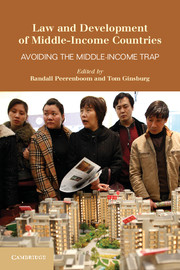Book contents
- Frontmatter
- Contents
- List of Contributors
- Acknowledgments
- 1 Law and Development in Middle-Income Countries
- Part I The Politics of Development in Middle-Income Countries
- Part II Middle-Income Countries in a Globalized Economy
- Part III Good Governance and the Rule of Law in Middle-Income Countries
- Part IV Socioeconomic Challenges in Middle-Income Countries
- Part V International Donor Strategies for Middle-Income Countries
- 15 The United Nations and Governance in Middle-Income Countries
- 16 Law and Development in Middle-Income Countries
- Appendix Selected Country Data as of 2011
- Index
- References
16 - Law and Development in Middle-Income Countries
Conclusion
Published online by Cambridge University Press: 05 June 2014
- Frontmatter
- Contents
- List of Contributors
- Acknowledgments
- 1 Law and Development in Middle-Income Countries
- Part I The Politics of Development in Middle-Income Countries
- Part II Middle-Income Countries in a Globalized Economy
- Part III Good Governance and the Rule of Law in Middle-Income Countries
- Part IV Socioeconomic Challenges in Middle-Income Countries
- Part V International Donor Strategies for Middle-Income Countries
- 15 The United Nations and Governance in Middle-Income Countries
- 16 Law and Development in Middle-Income Countries
- Appendix Selected Country Data as of 2011
- Index
- References
Summary
This chapter summarizes the key findings of this volume; locates these findings within the existing literatures on law and development and related fields; highlights areas for further research; and develops policy recommendations for middle-income country (MIC) governments and development agencies. The discussion is organized around the eight issue areas set forth in the introduction: (1) Is “middle-income country” an analytically useful category? (2) Is there a middle-income trap, are there various traps, or is it a myth? (3) What if anything do successful MICs share? (4) Why have East Asian states been so successful, and does the recent success of Central and Eastern European (CEE) states provide an alternative model? (5) What is the relationship between politics, or political-economy, and development in MICs? (6) How have MICs been influenced by and adapted to the new international economic order? (7) What approaches are available to MICs to address pressing socioeconomic issues? And finally, (8) what lessons are there for policy makers and development agencies in promoting rule of law and good governance in MICs? We conclude with some recommendations for future research.
IS “MIDDLE-INCOME COUNTRY” AN ANALYTICALLY USEFUL CATEGORY?
There are both quantitative and qualitative arguments in favor of MICs as a useful analytical category or concept. There is a well-established correlation between wealth, good governance, rule of law, the protection of human rights, and other indicators of human well-being. Nevertheless, sorting countries by levels of wealth provides additional insights because the relationship is not uniform at all levels of the income scale. Table 16.1 provides correlations between per capita income, the Governance Indicators of the World Bank, along with the Human Development Index and selected other indicators. Consistent with other work, we see strong overall correlations when all countries are included in the analysis (column 1). When one breaks down the correlations by income class, however, one sees differential links at different levels of income. The correlation coefficients are highest at the middle-income level, and the relationships are more significant. Dividing the MIC category into upper middle-income countries (UMICs) and lower middle-income countries (LMICs) provides further dividends. Again the correlation coefficients are higher at the lower level of wealth, that is, for LMICs than for UMICs, with equal or greater levels of significance.
- Type
- Chapter
- Information
- Law and Development of Middle-Income CountriesAvoiding the Middle-Income Trap, pp. 335 - 366Publisher: Cambridge University PressPrint publication year: 2014
References
- 3
- Cited by

